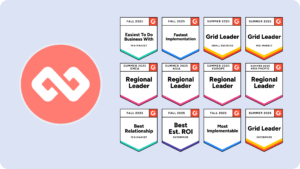For Human Resources and People & Culture professionals, finding ways to improve the employee experience at every stage of the employee lifecycle is an ongoing pursuit. Mentoring has emerged as an effective tool in this effort. Employers have embraced the idea of cultivating an organizational culture where every employee has someone to turn to for guidance, support, and insight. Mentoring has also become an integral piece in employees’ journeys throughout their careers within their organizations – from onboarding to their eventual retirement.
At Mentorloop, we believe that meaningful human connections are always beneficial, especially in the context of our working lives. So in this series, we’ll explore how mentoring fits into every stage of the employee lifecycle as well as why it should be a part of your team members’ experience from start to finish. While this can be a big undertaking, with mentoring software like Mentorloop, it can be made simple.
This is part one of our series on Mentoring for the 6 Stages of the Employee Lifecycle.
First, let’s start by exploring the employee lifecycle and how—and why—mentoring should be worked in at every stage.
What Is The Employee Lifecycle?
While your team member’s experiences will be unique, there are some significant similarities throughout the employee lifecycle. These include how they learn about your company, how they’re recruited and onboarded, why they decide to stay, and how their time with your organisation has impacted them.
It’s due to these shared similarities that the employee lifecycle model can be so useful. Think of it as a framework you can use as you consider your recruitment, onboarding, and retention strategies. Furthermore, by dividing the employee journey into six stages, companies can identify areas where they can improve their practices and policies as well as develop initiatives and programs where needed. These six stages of the employee lifecycle are:

In this series, we intend to take a close look at each.
Mentoring and the Employee Lifecycle
We’ve already written at length about why mentoring is one of the most valuable strategies a business can use to nurture and develop employees. Now we want to take a look at how you can use the wonderful tool that is mentoring at every single stage of the employee lifecycle.
This won’t only help you make the most of your mentoring program and software. It will also allow you to keep employees happy and get the most out of their mentoring relationships at every step of their journey with your company.
Benefits of Mentoring Throughout the Employee Lifecycle
Mentoring has a wealth of advantages for the individual entering a new organization. It can be a powerful tool in helping people gain experience and understand their place in their new workplace. This support can be invaluable when navigating a new job, as mentors can provide advice on key processes as well as offer emotional support as employees adjust to their roles. Beyond the onboarding stage, mentors also can provide informational guidance about other areas of the organization and encourage professional development during the course of an individual’s career.
Mentoring can also have positive impacts on employee morale, with those who are mentored feeling valued and supported while they learn the ropes. There is also evidence to suggest that having a mentor can help to reduce burnout and increase job satisfaction, leading to better job performance long term.
And for the organization as a whole, mentoring helps ensure that employees are well-equipped to handle the challenges of their roles. This leads to increased productivity and improved job satisfaction, resulting in a more successful and productive workforce.
So from just a general overview, there are plenty of benefits going around!
Why Have Mentoring at Every Step of the Employee Journey
The plethora of benefits that mentoring can bring to your organisation and your employees can differ at each stage of the employee lifecycle.
For example, mentoring can play a pivotal role in helping employees successfully transition from job to job within the organization. By having a trusted colleague to come to for advice, employees can take on a new role much more prepared and with more confidence than if they didn’t have a mentor’s support. In the onboarding stage, the benefits of mentoring are different. It helps employees get familiar with a new environment faster, learn the ropes, and have a clearer understanding of their role.
Additionally, what mentoring can do for retention is amazing. High-quality mentorship can encourage employees to remain loyal to their employer and actively contribute to the progress of their organization. Today, millennials in the workforce not only actively want mentors but deem them crucial for success. Employers can use mentoring programs to encourage employees to remain with their organization by providing them with the development they need to advance in their careers.
Mentoring can also help to create a more positive work environment. By providing employees with the opportunity to consistently learn from each other, it can help to foster a culture of collaboration and support. This can lead to increased job satisfaction and improved morale, which can ultimately result in higher productivity and better performance. And who doesn’t want that throughout their organization?
So it just makes sense to consistently have this endeavour be a part of the whole employee experience – not just at the beginning or the middle.
Maximizing The Potential of Mentoring Across The Employee Lifecycle
In order for mentoring initiatives to be effective, it’s essential for employers to adhere to best practices. Consider utilizing your existing team for mentoring rather than hiring external ones. This helps cut costs and maintain consistency throughout the organization. So look at your existing talent pool – it’s full of mentors! There’s no need to look outward to find people who can share knowledge and experiences. Your own people are your best asset when it comes to mentoring.
It’s also good to ensure that both mentors and mentees are given some type of support – whether that comes in the form of training or resources. It’s important that both parties know what’s expected of them and what their responsibilities are. It helps them have more pleasant experiences with their mentoring partners and avoid having a negative impact on each other’s development and morale.
Flexibility is also important when designing a mentoring program. Mentors and mentees should be given some freedom to adjust their experience to meet their specific goals and needs. Everyone is different and forcing all of your employees to adhere to a very specific and narrow path will only turn them off. Open conversations should be also encouraged. Fostering an environment where both participants feel comfortable expressing themselves freely can help establish trust and increase motivation.
It is also important to ensure that the mentoring program is regularly evaluated and updated. This will help to ensure that the program is meeting the needs of both the mentor and mentee. Seek regular feedback from both parties to ensure that the program is working as intended.
Leveraging Mentoring For Improved Employee Experience
Mentoring is one of many factors that employers should consider when implementing strategies for improving workplace experience. Its plethora of benefits can serve your employees and organization in many ways at every stage of the employee lifecycle. Not only does it help organizations with retention, employee morale, and recruitment, but it also supports the employees within it. As discussed above, mentoring supports individuals in many ways throughout their entire journey.
In this series, we explore how each stage of the employee lifecycle benefits from a mentoring program.
In Part Two, we talk about how mentoring can be an asset when attracting new talent.
Ready to see the impact a mentoring program can have on your company?
Mentorloop’s Enterprise solution fits into large organisations’ employee experience design at every stage.
Built with enterprises and large associations in mind, Mentorloop Enterprise takes your mentoring program to the next level with powerful algorithmic matching, customisations, single sign-on and more.
Learn more about Mentorloop Enterprise today.


![[Webinar Kit] Mentoring for the 6 Stages of the Employee Lifecycle Learn how to make mentoring a core part of the employee experience and why it pays off at every stage.](https://no-cache.hubspot.com/cta/default/4058869/interactive-189627182868.png)


